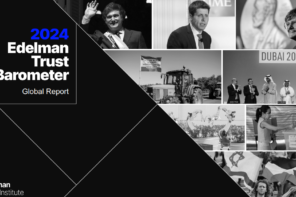
Monday July 22, 2024
The Impact of Thought Leadership: Edelman and LinkedIn B2B 2024 Report
Currently, B2B marketers in 2024 are in a challenging period, with 95% of business clients not actively seeking services or goods. David Callaghan of Edelman Ireland states, “Economic challenges and longer sales cycles are hitting many B2B companies hard.” He adds, “To grow, B2B marketers must engage buyers who aren’t actively shopping yet.” However, he concluded that “well-crafted thought-leadership can create urgency among B2B audiences … helping to kickstart the purchasing process.”
This year’s report surveyed nearly 3,500 management-level professionals from a varying range of industries and company sizes during December 2023 across seven varying geographic markets. The markets included were the United States, Canada, United Kingdom, Germany, Singapore, Australia and India. The survey asked these professionals for their insight into how high-level thought leadership increases brand awareness and encourages buyers to rethink their assumptions. This also serves as a pre-emptive defence against other competitors in the market.
What Is Thought Leadership?
Thought leadership, as defined in the report, is ‘content that offers expertise, guidance or a unique point of view on a topic or in a field.’ This content includes thought pieces, essays, videos, webinars, live presentations, and research reports that are readily available by organisations to the public for free.
Tusar Barik, senior director of marketing at LinkedIn, describes thought leadership as a “powerful tool for brands”, stating that it’s an “opportunity for B2B brands to differentiate themselves while establishing credibility and creating a lasting impression”.

Here are some key findings from the report:
- Thought leadership is a powerful tool for stimulating demand for a business’s product and services: Executives trust thought leadership over marketing material. Nearly three-fourths of decision-makers say that thought-leadership content is more trustworthy for assessing an organisation’s capabilities and competencies than its marketing materials. More than 75% of decision-makers and C-suite executives say a piece of thought leadership has led them to research a product they were previously not considering.
- Effective thought leadership strongly influences sales and pricing: 9 in 10 decision-makers and C-suite executives say they are more receptive to sales from a company that consistently produces high-quality thought leadership.
- Protecting your existing customers by providing strong thought leadership is vital: 70% of C-suite leaders say that a piece of thought leadership had led them to question whether they should continue working with an existing supplier. Additionally, 25% said that a piece of thought leadership led to them ending or significantly reducing their relationship with a current provider/supplier.
- Most organisations say thought leadership is under-resourced, misused, and not measured appropriately: Nearly one in five B2B companies said they did not have any process to measure the effectiveness of thought leadership. Furthermore, 30% of thought leadership producers said their organisation does not fully know how to optimise thought leadership as a marketing or sales tool, and 50% cited under-resourcing as a primary barrier to producing effective thought leadership. Ultimately, thought leadership is heavily underestimated in its importance of driving RFP (request for proposal) invitations; a small 38% of thought leadership producers expect their content to get them invited in an RFP process, which is opposed by 86% of decision-makers concluding that they are more likely to invite organisations that produce high-quality leadership to participate in the RFP process.
- High-level thought leadership cites strong research and data, helping buyers understand their business challenges, and offers solid guidance: Experienced authors and intriguing formats are essential, with 66% of decision-makers stating that a unique format or style was characteristic of an average or above average thought leadership piece). 55% also concluded that the highest quality thought leadership references strong data and research.
Public Relations and Thought Leadership:
Most potential customers aren’t looking for what you’re selling, but how can you change that? Thought leadership is a proven strategy for challenging buyers to rethink the status quo and stimulate buying journeys. However, even the best content can struggle to win attention. Media relations gives your thought leadership the ‘surround sound’ of media and influencer support, and direct experiential customer engagement. It can be the breakthrough you need in today’s noisy markets and the difference between success and failure.”
– James Ollerenshaw, Co-Founder and Chairman of Curzon PR
As our Co-Founder James explains, public relations can positively amplify the effect of thought leadership and boost credibility through carefully crafted thought leadership pieces in the right media outlets at the right time.
Curzon PR is a London-based PR firm working with clients globally. If you have any questions, please feel free to contact our Business Development Team bd@curzonpr.com






Follow us